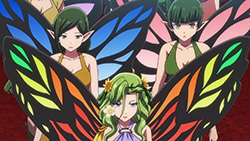 |
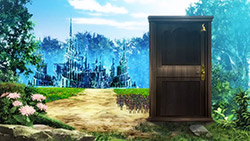 |
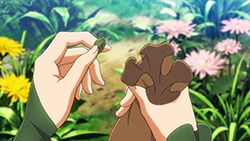 |
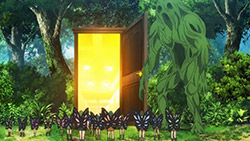 |
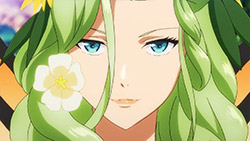 |
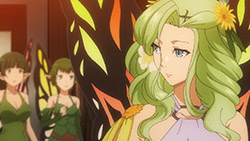 |
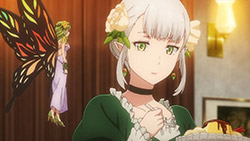 |
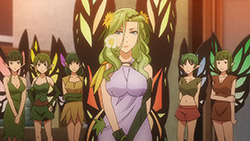 |
 |
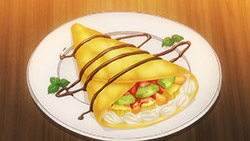 |
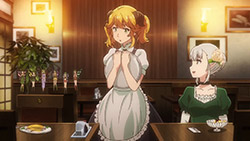 |
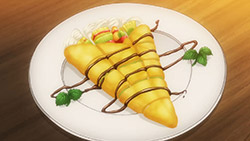 |
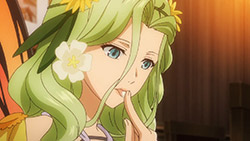 |
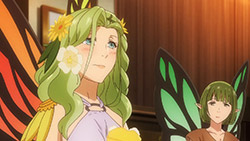 |
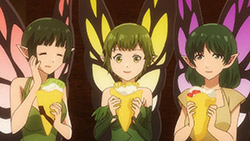 |
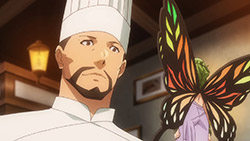 |
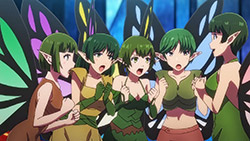 |
 |
 |
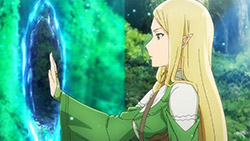 |
 |
 |
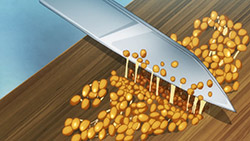 |
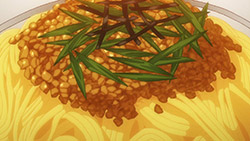 |
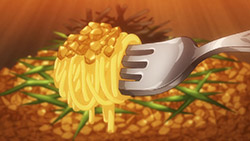 |
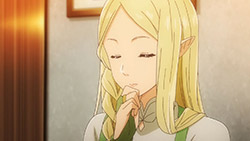 |
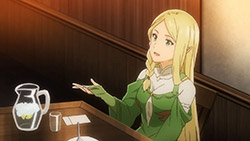 |
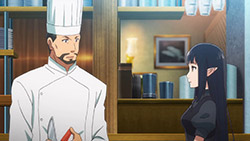 |
 |
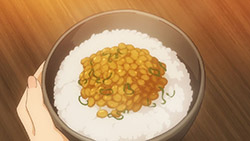 |
 |
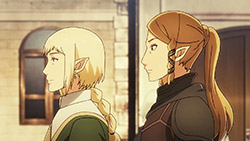 |
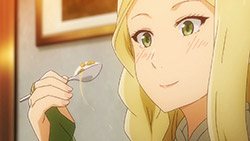 |
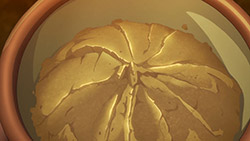 |
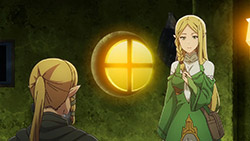 |
 |
「クレープ/納豆スパ」 (Kurepu/Natto Supa)
“Crepes/Natto Spaghetti”
Those rotten beans really do natto seem like my cup of tea, which means by default, I’ll be making the crepes next week.
Titania
The fairies as a group were fun and cute, but the Queen herself presided on a whole other level. Graceful in form, and expressing a fair regality befitting of her status, she exudes an utterly charming presence that completely dominated the screen. Though I’m pretty tired of new customers exhibiting caution regarding the unknown, seeing how it’s been done do death by this point, I quite liked how the Fairy Queen sought out the customer with the highest magical aptitude as if that alone was enough to warrant some trust. Mutual cooperation between races in a fantasy setting never fails to put a smile on my face, and it was great to see the Fairy Queen and Victoria helping each other out. In exchange for magical fairy seeds which cannot be ordinarily obtained, Victoria agrees to buy the fairies crepes every week. Sounds like an extremely good deal, because I would exploit the gap in the economy to generate a lucrative black market for fairy seeds.
Miso Hungry
I see Christian as a parallel for travellers reinventing a great experience they had abroad, to fit in a context of their own cultural tastes. Through the ages, we’ve seen this occur multiple times in ways that have even altered the course of human history. One particular example that comes to mind, is the common thought that Marco Polo brought pasta to Italy in the 13th Century, having been inspired by the noodles he ate during his travels in China. People might cry about culinary appropriation, and it’s true we all have our own preferences. But I think pitting foods against each other ignores centuries of complex developments, uniquely defining either cuisines in ways that cannot be compared. In short, I’m simply just grateful that we get a variety of great foods with their unique twists, and appreciate the diversity of culinary riches available to me in a country that actively benefits from globalisation.
Fardania shows what’s so fun about trying new combinations with food that others might not imagine. Potentially not applicable in this scenario, since Natto and Rice is a de facto combination, but my point being that she considered a great possibility beyond what the menu stipulated. At university, I might get laughed at by my friends for suggesting certain kind of substitutes for recipe ingredients that we are short on. Most notably, people were hugely skeptical when I used a litre of coca cola to stew some pork belly in the absence of sugar and fragrant spices. But hey, it worked, and everyone ended up agreeing that it tasted fabulous!
Concluding Thoughts
You may be wondering what Tenshu meant, when he displayed a reluctance to serve the Natto on Rice, citing it as something traditionally Japanese. After all, considering certain items on his menu (teriyaki, Omurice, Katsudon, Tempura, etc), hasn’t he already been doing it for most of the series? Some quick research showed the word ‘Yoshoku‘ doesn’t literally mean Western food, rather it means Western-inspired food. Such a crucial distinction is very important concerning the identify of Isekai Shokudou, because I think that the fusion of different cuisines is microcosmic in regards to the overlap between the human and fantasy worlds. Two different things come together, creating something new and wonderful, and in my contrived opinion, this is exactly a part of what defines Nekoya.
Preview
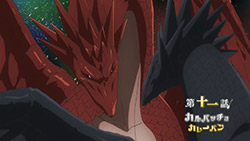 |
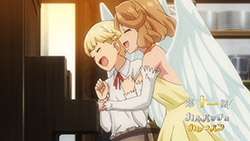 |
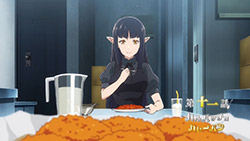 |
Zaiden’s Homemade Deep Fried Seafood Platter
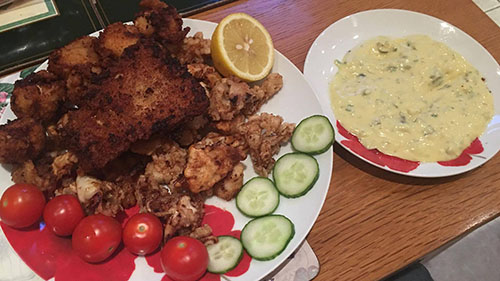 |
|
Ika-Musume, noooo-de geso! |
You see everything in this picture? It was all made from scratch. Most of it started off as fresh seafood from the fishmongers, which I battered and deep fried. Sounds easy, but it was so much effort. The moisture of the squid significantly lowered the temperature, so the scallops and cod fillet fried in a soggy manner, struggling to achieve the crisp Nirvana I was striving for. I just about managed, though I had to sacrifice my golden brown for a bit of charcoal around the edges, but it was worth it. The dwarves tricked me into thinking that I could have a massive plate for myself. Unfortunately, I fell very short of finishing the whole plate, and had to store the rest in the fridge for a later date.
One things for sure. After making that tartar sauce, and getting hands on experience with the ridiculous quantities of oil, I think mayonnaise is now ruined for me.
Final Rating: 3.8/10 – Everything tasted fantastic, but using an electric stove (due to lacking a deep fat fryer) proved to be a significant limitation. The calamari was spot on, but the scallops and cod ended up being slightly burnt, and the tartar sauce really could have used some more capers and pickle juice.

I agree that the interaction between the Fairy Queen and Victoria was awesome.
Ongoing questions:
Why would it be too disruptive for the other customers to dine with the Red Dragon of Fire (in human form) while no one is concerned that the Black Dragon of Death (in human form) is a waitress? What about that “weak death magic” thing?
When do we find out anything about the beer drinking White Wizard?
99.9% sure the wizard is Merlin, or at least his counterpart in anime form
I think the LNs mention the Red Dragon’s reputation as a ruthless monster is what scares other customers.
Like if a Yakuza freely walked into a restaurant in Japan without bothering to hide their identity.
Not sure about Kuro though.
Chances are no one knows of the Black Dragon since it disappeared just after “the dawn of time.” I would say the black magic of death only works were Kuro is in human form or the restaurant is a magic free zone? I don’t recall anyone using magic in the restaurant. I will be the white wizard knows of Kuro through his research, he seemed more afraid of the two dragons competing than Kuro herself. I’ll bet the wizard is among the first customers to the restaurant, and had a hand in creating the door, he did write the original menu.
Black magic only works when Kuro is in dragon form.
Her telepathy still works, so i’m guessing magic still works fine in our world.
What yoshoku foods were you able to try in Japan, Zaiden?
(Other than curry, which you mentioned in a previous post.)
The fairy story is cute! If a fairy comes alone, the chef should try to cook a crepes for ants.
https://randomc.net/image/Isekai%20Shokudou/Isekai%20Shokudou%20-%2010%20-%2023.jpg
I always wonder how does natto taste like and, being an adventurous eater, I’d like to eat it someday.
I asked about this once, and while my wife’s never fed us Natto, her friends (and my friends’ wives) have apparently tried it once – and once was enough.
In the cultural context, Natto in our local circle is considered something of an elitist’s diet – much like the “Organic”, “Vegan” or “Non-GM” craze. Yes, it has a Japanese origin, but most people here in the States don’t latch onto Natto because they grew up with it, let alone like it; one of my colleague’s daughter worked as a waitress at a local restaurant, and she tells us stories of diners with “unique palettes” some of whom ate Natto (in its unvarnished form) as a status symbol. Some offered it to the friends they brought, who would end up gagging – and vomiting – but who would hold “brave faces” out of peer pressure and self-righteousness. As a waitress, she was especially trained to look out for these instances, since the smell alone (to say nothing of the vomiting) disturbed the other customers\ -try to warn them away from Natto – but this “strata of special people” (actually, they’re not any different from us income-wise) insist. Many keep coming back for more.
Basically, Natto’s appeal is for people who want to feel morally superior to others, a “health” food. My family doctor (who’s delivered and cared for four generations of my family) has mentioned Natto (among others) as part of the phony “health craze” that he consistently has to warn his patients against. Particularly older patients.
Anyway, Natto and its “taste” was explained to us thusly: any common-sense person knows the onset of spoilage by smelling it or touching it. Our instincts are naturally geared towards detecting such spoilage in foods: sulfides, organic acids, ammonia, etc. Natto is no different. Yes, it is spoiled. Yes, the texture is infirm just as it would be in spoiled vegetation and meat since the bacteria is breaking it down. Yes, it is slimy because the bacteria is colonizing the rotten surface.
Can you prepare rotten pork, covering up most of its smell and eat it with no ill effects?
Yes, and indeed this is how Natto is prepared much of the time.
Should you?
That’s a different question entirely. Why not eat foods that don’t tax your system (not to mention your instinctive gag reflexes meant to prevent you from ingesting rotten food) at all?
A young person’s immune and digestive system would probably be able to handle spoiled food like Natto, but there have been many cases of poisoning making the rounds among physicians and care-givers and, no, they’re not the result of allergy.
An older person? My doctor says absolutely not.
And no, I don’t need to try something to be able to talk about it, let alone feed it to our kids or grandfather just to find out.
Spoilage is a form of cooking though, fermentation. Cheese is spoiled milk. Kimchi is spoiled cabbage. Wine is spoiled grape. Beer, one of the first foods (and debatably the reason why we moved from hunter gatherer to agriculture) is spoiled barley/wheat.
I think natto, much like other fermented foods, is a product of culture. In Korea, children are educated to love it. They have classes set aside in kindergarden and elementary to visit kimchi factories, kimchi school lunches and make their own kimchi as part of school curriculum. Most fermented products are not cross-cultural either — for instance, I grew up eating chincalok (fermented shrimp paste) and I can’t stand most cheese or yogurt. It doesn’t suit my palate and for me, the taste of spoiled dairy is disgusting. And yet, when most people visit my country, chincalok, durian and other things are considered “disgusting” to them.
In terms of health, fermented foods contain extremely high levels of probiotics that help keep your gut bacteria healthy. Fermented foods in moderation is good for you — if you don’t like natto, you can have cheese instead. If you don’t like cheese, you can have kimchi instead. Or saukeraut. Or pickled gardenia. Or any of the multiple cuisines in the world that have “spoiled” food as part of their main cuisine.
I just think it’s unfortunate if you simply not eat any “rotten” food. Careful, controlled rot is an important part of human culture, and one of the ways we managed as a species to survive long and harsh winters, to develop extraordinary techniques of preservation in order to survive, and now, enjoy.
https://randomc.net/image/Isekai%20Shokudou/Isekai%20Shokudou%20-%2010%20-%20Large%2005.jpg
Man, what is it with fantasy worlds and utterly gorgeous women?
“Those rotten beans really do natto seem like my cup of tea.”
Dammit, Barb! XD (Cookie to who gets the reference)
“Sounds like an extremely good deal, because I would exploit the gap in the economy to generate a lucrative black market for fairy seeds.”
Psst, mind letting me in on it? <__> XD
Natto isn’t rotten beans, it’s beans in a slime of long-chain polysaccharides that contains millions of bacteria per gram. My local Chinese store stocks it, great with Japanese breakfast.
How do fairies reproduce, if they are all women?
Clearly they’re born from flower seeds. 😉
How do fairies reproduce?
“Passionately”.
This show is my little corner of happiness every week =)
+1 for thicc fairy queens.